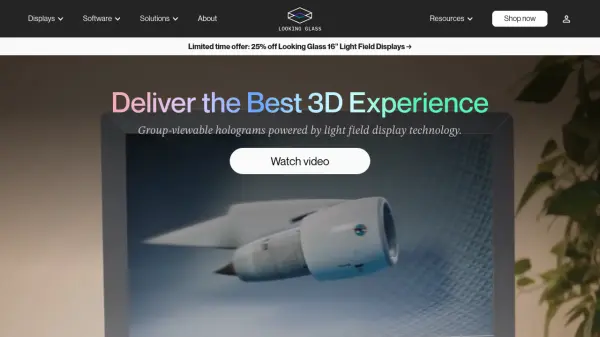What is Looking Glass?
Looking Glass is a cutting-edge platform that integrates proprietary light field display hardware and AI-powered software to create true-to-life 3D holograms viewable by groups without the need for headsets or special glasses. Users can transform 2D images, generative AI content, and 3D models into lifelike holographic experiences, ideal for interactive presentations, retail activations, educational tools, and creative showcases.
The system supports a diverse set of media including standard images, videos, depth maps, 3D models, and real-time interactive apps developed in popular 3D engines like Unity and Unreal. Advanced features like AI-driven 2D-to-3D conversion, cloud-based photo management, playlists, and deep editing tools offer unmatched flexibility for developers, educators, creatives, and innovators across industries.
Features
- Headset-Free 3D Holograms: Delivers group-viewable, realistic 3D content using proprietary light field technology.
- AI Uplift for 2D-to-3D: Converts 2D photos, images, and videos to 3D holograms using AI-driven depth mapping.
- Multi-User Viewing: Projects up to 100 perspectives, enabling simultaneous viewing by large groups within a 53° cone.
- Interactive Application Support: Integrates with Unity, Unreal, and Blender for real-time 3D apps and complex models.
- Mobile and Cloud Integration: Upload, manage, and share holographic content from phones or web browsers.
- Flexible Media Playback: Supports a wide range of files, including OBJ, FBX, STL, GLB, and light field images.
- Advanced Editing Tools: Adjust depth, zoom, and focus of 3D photos using the mobile app.
Use Cases
- Showcasing educational 3D content for classroom engagement and training sessions.
- Delivering retail, entertainment, and brand activations with immersive holographic displays.
- Presenting complex scientific, engineering, or biotech visualizations in research or innovation labs.
- Displaying interactive 3D product demos or prototypes to clients or stakeholders.
- Turning generative AI images into dynamic, physical 3D holograms for art and design.
- Organizing and sharing personal 3D photo playlists among friends and family.
FAQs
-
Can multiple people view the 3D content at once?
Yes, Looking Glass displays allow groups to naturally see true 3D holograms simultaneously, with up to 100 perspectives visible within a wide viewing angle. -
How do I turn generative AI images into holograms?
You simply upload generative AI images, such as those from Midjourney or DALL-E, via the app or web, and the system automatically adds 3D depth for display. -
What types of content are supported?
Looking Glass supports 2D photos and videos (with AI 3D uplift), depth maps, 3D models in formats such as OBJ, FBX, STL, and GLB, and real-time applications built with Unity, Unreal, or WebXR. -
Is there onboard storage for 3D content?
Yes, devices like Looking Glass Go provide onboard storage capable of holding thousands of holograms for offline display. -
How can I organize and share my 3D photos?
You can create playlists in the app, share them publicly or privately, and manage content via cloud accounts for easy access across devices.
Helpful for people in the following professions
Looking Glass Uptime Monitor
Average Uptime
99.72%
Average Response Time
119.4 ms
Featured Tools
Join Our Newsletter
Stay updated with the latest AI tools, news, and offers by subscribing to our weekly newsletter.








